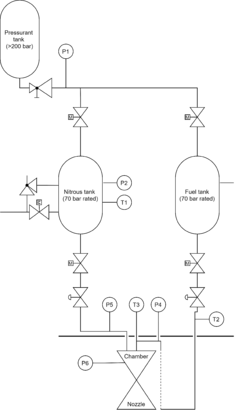Difference between revisions of "White Giant"
m (Spelling) |
(Added test stand) |
||
| Line 26: | Line 26: | ||
=== Test stand === | === Test stand === | ||
The Griffin test stand represents a significant step up in testing hardware from previous rockets. It will be designed to test many aspects of the overall flight system (cold flow, hot firing, pressure-testing tanks, instrumentation validation) with high quality hardware. | |||
[[File:White Giant test stand P&ID.png|thumb|410x410px|The P&ID diagram (plumbing and instrumentation diagram) showing the core of the hot-fire test stand.]] | |||
[[Category:Griffin]] | [[Category:Griffin]] | ||
[[Category:Technical Project Overview]] | [[Category:Technical Project Overview]] | ||
Revision as of 18:26, 25 April 2021
White Giant is the first flight-ready liquid engine rocket engine developed by CUSF. The project was initiated in January 2021, with the goal of producing a 10kN engine burning isopropyl alcohol and nitrous oxide for the Griffin rocket. The engine used regenerative cooling with the fuel, has a designed burn time of 30-40 seconds and a low chamber pressure to reduce system mass. The precursor to White Giant is the White Dwarf test engine, which aims to test many of the principles of the full-size Giant (injection, cooling, plumbing, ignition) on a smaller and more manageable engine.
History
The White Giant engine was first conceived by Sam Ross in early 2020 as the booster engine for the (then-named) Martlet V two-stage rocket designed to pass the Kármán line. An initial analysis of the performance of this vehicle was presented at the 2020 AGM, where it was agreed that Martlet V would be the society's next project.
The project was largely dormant during 2020, but was officially started in January 2021. The various subteams proceeded with literature reviews, exploratory modelling and some initial design work. As of April 2021, many of the teams are proceeding towards initial designs.
White Dwarf
In order to build up experience for White Giant, the first engine produced by the society will be White Dwarf. This is a subscale engine that uses the same architecture for all critical components. The development and test firings of White Dwarf will allow the validation of much of the modelling carried out, as well as testing the ability of the society to manufacture and fire a liquid engine. The optimistic timeline for the White Giant program aims for a test firing of White Dwarf before the end of the 2021/22 academic year.
Sub teams
Due to the volume of work involved with White Giant, a number of sub teams with independent project managers have been formed. Each sub team is responsible for a particular key subsystem of the engine.
Cooling
Injector
The injection system for White Giant is responsible for delivering the isopropyl alcohol and nitrous oxide to the combustion chamber while atomising and mixing them, so they may combust effectively. One of the main issues faced when designing an injector plate is that of reducing combustion instability, an effect that causes destructive vibrations and oscillations within the propulsion system, and often causes a rocket's early demise.
The injector uses passive mass-flow limiters in the form of cavitating venturis upstream of the combustion chamber. The fuel venturi lies upstream of the injector manifold, while the venturi system for the oxidiser will be in the injector orifices themselves. This will be achieved by manipulating the temperature of the oxidiser so that its vapour pressure lies within the pressure drop range of the injector orifices, i.e. the nitrous will begin to vaporise in the orifice, and choke the mass flow rate.
A software package called octopus was written in order to model the flow of propellant through the injector, and was used to specify design parameters for the injector plate such as total injection area and pressure drop.
Tanks
Test stand
The Griffin test stand represents a significant step up in testing hardware from previous rockets. It will be designed to test many aspects of the overall flight system (cold flow, hot firing, pressure-testing tanks, instrumentation validation) with high quality hardware.

